

News
New Elon Musk essay: Tesla CEO’s current thoughts on technology and humanity
It’s been a while since Elon Musk published an extensive blog post outlining his stance on a specific topic. On the official Tesla website, his last blog post was on August 24, 2018, when he explained his decision to keep Tesla a publicly-traded company. Fortunately, a new Elon Musk essay has been posted in China, outlining the Tesla CEO’s thoughts on a number of topics — from sustainability, the Tesla Bot’s real-world use, Neuralink’s focus on the disabled, and SpaceX’s exploration aspirations.
The new Elon Musk essay was published in China Cyberspace, the Cyberspace Administration of China’s (CAC) flagship magazine. A translation of the essay was posted by Yang Liu, a journalist from the state-owned news agency Xinhua, on the Beijing Channel blog. As could be seen in Liu’s post, Musk actually discussed a number of topics in detail.
In a way, the publication of the new Elon Musk essay in the CAC’s flagship magazine is significant. As noted by The Register, Musk’s essay suggests that Chinese authorities approve of the Tesla CEO’s positions on the topics he discussed. Only a few other foreign entrepreneurs would likely be given the same honor.
Following is the full text of Elon Musk’s new essay.
Believing in Technology for a Better Future
Thank you for the invitation from China Cyberspace magazine. I am pleased to share with my Chinese friends some of my thoughts on the vision of technology and humanity.
Posted by Elon Musk
As technology accelerates, it may one day surpass human understanding and control. Some are optimistic and some are pessimistic. But I believe that as long as we are not complacent and always maintain a sense of urgency, the future of humanity will be bright, driven by the power of technology. It is like a self-fulfilling prophecy: if humans want to make the future good, they should take action to make it good.
I want to do everything we can to maximize the use of technology to help achieve a better future for humanity. To that end, any area that contributes to a sustainable future is worthy of our investment. Whether it’s Tesla, Neuralink, or SpaceX, these companies were all founded with the ultimate goal of enhancing the future of human life and creating as much practical value for the world as possible—Tesla to accelerate the world’s transition to sustainable energy, Neuralink for medical rehabilitation, SpaceX for making interstellar connections possible.
Clean Energy: The Future of Sustainability
The starting point for my thinking about clean energy is how to create and store energy sustainably and for the long term, and how to provide a constant source of power for the future of productive life. In my view, the future of sustainable energy involves three components.
The generation of sustainable energy. The sun is like a giant fusion generator, from which mankind currently exploits a tiny amount of energy. In the long run, solar energy will become the main source of energy for human civilization. Of course, wind, hydroelectric, geothermal, and nuclear power are also useful energy supplements.
The storage of sustainable energy. Given the change of day and night and the change of weather, we need a lot of fixed battery banks to store solar and wind energy, because the sun does not shine all the time, and the wind does not blow all the time, energy needs to be stored in a large number of fixed battery banks.
Electrified transportation. Full electrification of transportation, including cars, planes, and ships. Electric rockets may be more difficult, but we may be able to manufacture the propellant used in rockets from sustainable energy sources. Eventually, the world economy will be run entirely by sustainable energy sources.
The world is on track for a sustainable energy transition, and humanity should continue to accelerate the process. The faster this transition is achieved, the less risk humanity poses to the environment and the more it will gain. When clean energy is available, carbon sequestration and desalination will be cheaper, climate change and water shortages will be solved, and when fossil fuels are out of the picture, the skies will be cleaner, the world will be quieter, the air will be fresher, and the future will be brighter.
Solar power, battery packs, and electric vehicles paint a rosy picture. Next, we need to focus on the limiting factors. The electrification of cars has become a consensus among nations, but battery support on a terawatt-hour scale is needed to roll out pure electric vehicles around the globe. According to our estimates, the world needs about 300 TWh of battery storage to achieve a transition to sustainable energy. The biggest difficulty in advancing sustainable energy lies in the large-scale production of lithium battery cells. Specifically, from the mining and element refining to battery cells coming off of the production line and finally assembled into battery packs, this is a complex process that is restraining the rapid development of a sustainable energy economy.
As a pioneer and innovator focusing on energy innovation technology, Tesla was founded to solve the problem of energy innovation. On the one hand, we create integrated sustainable energy products from the three segments of energy production, storage and use; on the other hand, we are committed to redefining battery manufacturing by innovating and developing advanced battery technology to remove restrictions on battery capacity. I believe that the world will transition to a sustainable future through a combination of solar and wind energy plus battery storage and electric vehicles. I am pleased to see more and more companies joining this field. Chinese companies will be a force to be reckoned with in the cause of energy innovation.
Humanoid Robots: Doing What Humans Do
Today’s cars are increasingly like smart, web-connected robots on wheels. In fact, in addition to cars, humanoid robots are also becoming a reality, with Tesla launching a general-purpose humanoid robot (Tesla Bot) in 2021. The Tesla Bot is close to the height and weight of an adult, can carry or pick up heavy objects, walk fast in small steps, and the screen on its face is an interactive interface for communication with people. You may wonder why we designed this robot with legs. Because human society is based on the interaction of a bipedal humanoid with two arms and ten fingers. So if we want a robot to adapt to its environment and be able to do what humans do, it has to be roughly the same size, shape, and capabilities as a human.
Tesla Bots are initially positioned to replace people in repetitive, boring, and dangerous tasks. But the vision is for them to serve millions of households, such as cooking, mowing lawns, and caring for the elderly.
Achieving this goal requires that robots evolve to be smart enough and for us to have the ability to mass produce robots. Our “four-wheeled robots” – cars – have changed the way people travel and even live. One day when we solve the problem of self-driving cars (i.e., real-world artificial intelligence), we will be able to extend artificial intelligence technology to humanoid robots, which will have a much broader application than cars.
We plan to launch the first prototype of a humanoid robot this year and focus on improving the intelligence of that robot and solving the problem of large-scale production. Thereafter, humanoid robots’ usefulness will increase yearly as production scales up and costs fall. In the future, a home robot may be cheaper than a car. Perhaps in less than a decade, people will be able to buy a robot for their parents as a birthday gift.
It is foreseeable that with the power of robots, we will create an era of extreme abundance of goods and services, where everyone can live a life of abundance. Perhaps the only scarcity that will exist in the future is for us to create ourselves as humans.
Neuralink: Empowering the Disabled
Some of our Chinese friends may not be as familiar with Neuralink as with electric cars. These companies focus on developing computer-human brain fusion technologies, developing brain chips the size of coins, similar to wearable devices such as smartphones, except that they integrate more deeply with the user’s body—recording and stimulating brain activity through implants in the cerebral cortex.
At this stage, the technology is helping injured people on an individual level. We have received many saddening letters: a 25-year-old young man was in the prime of his life when he had a motorcycle accident that left him unable to eat on his own, which is a great grief for the individual and the family. In light of this, brain-machine interface technology will be focused on curing or alleviating brain injury and other related disorders in the years to come. For example, it could help restore sensory or motor function to limbs of those with spinal injuries and mental system disorders or allow quadriplegics to use their brains to easily operate computers or cell phones.
This technology can also improve a wider range of brain injury problems, whether these disorders are congenital or accidental, or caused by age and external stressors, including severe depression, morbid obesity, sleep problems, and underlying schizophrenia, all of which are expected to be alleviated by human-computer devices.
With the development of brain-machine interface technology, in the long term, this connection is expected to expand the channels of communication between the outside world and the human brain, “accessing” more brain regions and new neural data. This technology could allow humans to effectively integrate with artificial intelligence and ultimately expand new ways for humans to interact with the world, themselves and others. Even if the goal of human-machine integration is difficult to achieve, brain-machine interface technology could be of great value in the field of medical rehabilitation.
Space Exploration: The Possibility of Cross-Planet Habitats
Finally, my greatest hope is that humans create a self-sustaining city on Mars. Many people ask me why I want to explore outer space and turn humans into multi-planetary creatures. In the vast universe, human civilization is like a faint little candle, like a little shimmering light in the void. When the sun expands one day and the Earth is no longer habitable, we can fly to a new home in a spaceship. If humans can inhabit other planets, it means that they have passed one of the conditions of the great screening of the universe, then we will become interplanetary citizens, and human civilization will be able to continue.
The first step toward interplanetary habitat is to reduce the cost of travel, which is what SpaceX was founded to do – first by building recoverable rockets and then by building reusable mega-ships with ever-increasing carrying capacity. As of earlier this year, SpaceX had successfully reused 79 rockets to deliver cargo to the space station and send ordinary people into space. We have also designed and built the largest launch vehicle in history, the Starship, which can carry 100 passengers and supplies at a time. In the future, we plan to build at least 1,000 Starships to send groups of pioneers to Mars to build a self-sustaining city.
As technology continues to change lives at an accelerating pace and the world evolves, life is more than simply solving one problem after another. We all want to wake up in the morning full of anticipation for the future and rejoice in what is to come. I hope more people will join us in our fight to accelerate the world’s transition to sustainable energy. I also welcome more like-minded Chinese partners to join us in exploring clean energy, artificial intelligence, human-machine collaboration, and space exploration to create a future worth waiting for.
***
Don’t hesitate to contact us with news tips. Just send a message to simon@teslarati.com to give us a heads up.

Cybertruck
Tesla updates Cybertruck owners about key Powershare feature

Tesla is updating Cybertruck owners on its timeline of a massive feature that has yet to ship: Powershare with Powerwall.
Powershare is a bidirectional charging feature exclusive to Cybertruck, which allows the vehicle’s battery to act as a portable power source for homes, appliances, tools, other EVs, and more. It was announced in late 2023 as part of Tesla’s push into vehicle-to-everything energy sharing, and acting as a giant portable charger is the main advantage, as it can provide backup power during outages.
Cybertruck’s Powershare system supports both vehicle-to-load (V2L) and vehicle-to-home (V2H), making it flexible and well-rounded for a variety of applications.
However, even though the feature was promised with Cybertruck, it has yet to be shipped to vehicles. Tesla communicated with owners through email recently regarding Powershare with Powerwall, which essentially has the pickup act as an extended battery.
Powerwall discharge would be prioritized before tapping into the truck’s larger pack.
However, Tesla is still working on getting the feature out to owners, an email said:
“We’re writing to let you know that the Powershare with Powerwall feature is still in development and is now scheduled for release in mid-2026.
This new release date gives us additional time to design and test this feature, ensuring its ability to communicate and optimize energy sharing between your vehicle and many configurations and generations of Powerwall. We are also using this time to develop additional Powershare features that will help us continue to accelerate the world’s transition to sustainable energy.”
Owners have expressed some real disappointment in Tesla’s continuous delays in releasing the feature, as it was expected to be released by late 2024, but now has been pushed back several times to mid-2026, according to the email.
Foundation Series Cybertruck buyers paid extra, expecting the feature to be rolled out with their vehicle upon pickup.
Cybertruck’s Lead Engineer, Wes Morrill, even commented on the holdup:
As a Cybertruck owner who also has Powerwall, I empathize with the disappointed comments.
To their credit, the team has delivered powershare functionality to Cybertruck customers who otherwise have no backup with development of the powershare gateway. As well as those with solar…
— Wes (@wmorrill3) December 12, 2025
He said that “it turned out to be much harder than anticipated to make powershare work seamlessly with existing Powerwalls through existing wall connectors. Two grid-forming devices need to negotiate who will form and who will follow, depending on the state of charge of each, and they need to do this without a network and through multiple generations of hardware, and test and validate this process through rigorous certifications to ensure grid safety.”
It’s nice to see the transparency, but it is justified for some Cybertruck owners to feel like they’ve been bait-and-switched.
News
Tesla’s northernmost Supercharger in North America opens

Tesla has opened its northernmost Supercharger in Fairbanks, Alaska, with eight V4 stalls located in one of the most frigid cities in the U.S.
Located just 196 miles from the Arctic Circle, Fairbanks’s average temperature for the week was around -12 degrees Fahrenheit. However, there are plenty of Tesla owners in Alaska who have been waiting for more charging options out in public.
There are only 36 total Supercharger stalls in Alaska, despite being the largest state in the U.S.
Eight Superchargers were added to Fairbanks, which will eventually be a 48-stall station. Tesla announced its activation today:
North America’s northernmost Supercharger Fairbanks, AK (8 stalls) opened to public. https://t.co/M4l04DZ6B5 pic.twitter.com/zyL6bDuA93
— Tesla Charging (@TeslaCharging) December 12, 2025
The base price per kWh is $0.43 at the Fairbanks Supercharger. Thanks to its V4 capabilities, it can charge at speeds up to 325 kW.
Despite being the northernmost Supercharger in North America, it is not even in the Top 5 northernmost Superchargers globally, because Alaska is south of Norway. The northernmost Supercharger is in Honningsvåg, Norway. All of the Top 5 are in the Scandanavian country.
Tesla’s Supercharger expansion in 2025 has been impressive, and although it experienced some early-quarter slowdowns due to V3-to-V4 hardware transitions, it has been the company’s strongest year for deployments.
🚨🚨 Tesla Supercharging had a HUGE year, and they deserve to be recognized.
🍔 Opened Tesla Diner, a drive-in movie theater with awesome, Chef-curated cuisine
🔌 Gave access to Superchargers to several EV makers, including Hyundai, Genesis, Mercedes-Benz, Kia, Lucid, Toyota,… pic.twitter.com/yYT2QEbqoW
— TESLARATI (@Teslarati) December 10, 2025
Through the three quarters of 2025, the company has added 7,753 stations and 73,817 stalls across the world, a 16 percent increase in stations and an 18 percent increase in stalls compared to last year.
Tesla is on track to add over 12,000 stalls for the full year, achieving an average of one new stall every hour, an impressive statistic.
Recently, the company wrapped up construction at its Supercharger Oasis in Lost Hills, California, a 168-stall Supercharger that Tesla Solar Panels completely power. It is the largest Supercharger in the world.
News
Tesla shocks with latest Robotaxi testing move
Why Tesla has chosen to use a couple of Model S units must have a reason; the company is calculated in its engineering and data collection efforts, so this is definitely more than “we just felt like giving our drivers a change of scenery.”

Tesla Model S vehicles were spotted performing validation testing with LiDAR rigs in California today, a pretty big switch-up compared to what we are used to seeing on the roads.
Tesla utilizes the Model Y crossover for its Robotaxi fleet. It is adequately sized, the most popular vehicle in its lineup, and is suitable for a wide variety of applications. It provides enough luxury for a single rider, but enough room for several passengers, if needed.
However, the testing has seemingly expanded to one of Tesla’s premium flagship offerings, as the Model S was spotted with the validation equipment that is seen entirely with Model Y vehicles. We have written several articles on Robotaxi testing mules being spotted across the United States, but this is a first:
🚨 Tesla is using Model S vehicles fitted with LiDAR rigs to validate FSD and Robotaxi, differing from the Model Ys that it uses typically
Those Model Y vehicles have been on the East Coast for some time. These Model S cars were spotted in California https://t.co/CN9Bw5Wma8 pic.twitter.com/UE55hx5mdd
— TESLARATI (@Teslarati) December 11, 2025
Why Tesla has chosen to use a couple of Model S units must have a reason; the company is calculated in its engineering and data collection efforts, so this is definitely more than “we just felt like giving our drivers a change of scenery.”
It seems to hint that Tesla could add a premium, more luxury offering to its Robotaxi platform eventually. Think about it: Uber has Uber Black, Lyft has Lyft Black. These vehicles and services are associated with a more premium cost as they combine luxury models with more catered transportation options.
Tesla could be testing the waters here, and it could be thinking of adding the Model S to its fleet of ride-hailing vehicles.
Reluctant to remove the Model S from its production plans completely despite its low volume contributions to the overall mission of transitioning the world to sustainable energy, the flagship sedan has always meant something. CEO Elon Musk referred to it, along with its sibling Model X, as continuing on production lines due to “sentimental reasons.”
However, its purpose might have been expanded to justify keeping it around, and why not? It is a cozy, premium offering, and it would be great for those who want a little more luxury and are willing to pay a few extra dollars.
Of course, none of this is even close to confirmed. However, it is reasonable to speculate that the Model S could be a potential addition to the Robotaxi fleet. It’s capable of all the same things the Model Y is, but with more luxuriousness, and it could be the perfect addition to the futuristic fleet.











